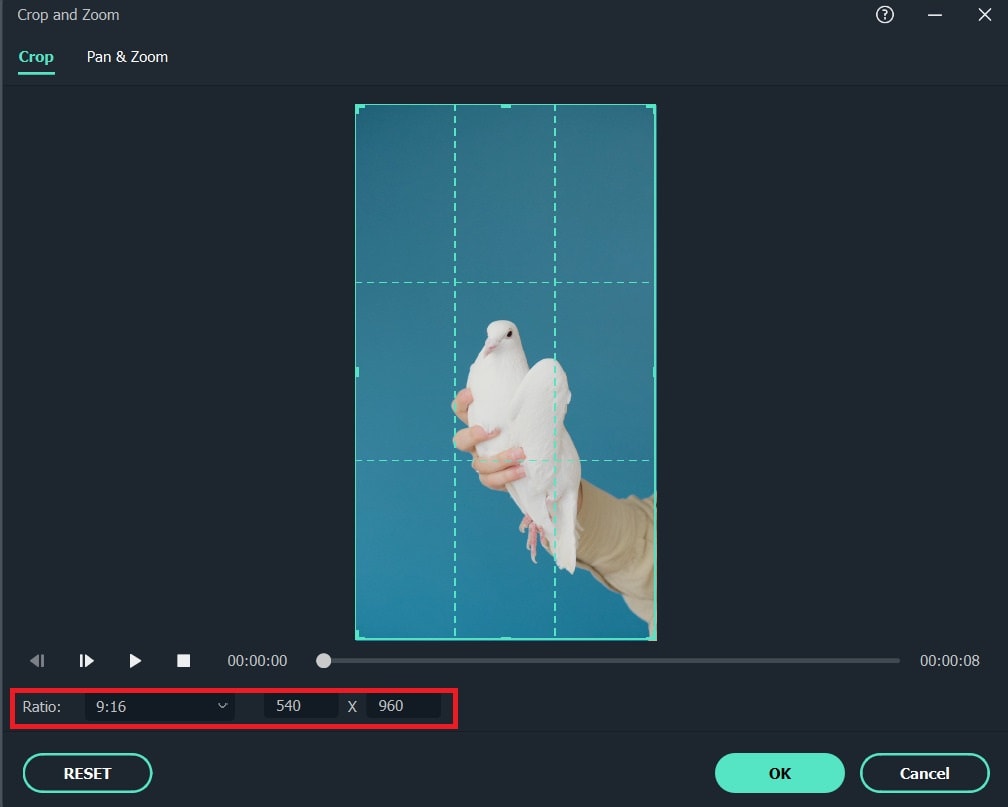
Updated Video Aspect Ratio How to Adjust and Customize

Video Aspect Ratio: How to Adjust and Customize
How to Change Shape of a Video?

Liza Brown
Mar 27, 2024• Proven solutions
While most videos nowadays are rectangular, and are recorded in either landscape or portrait orientation, there are some social media platforms that require the clips to be square shaped. If you want to upload your footages on such websites, it is essential to learn how to change video shape.
Another benefit of changing the shape of the recorded films is that they can be adjusted in limited amount of space, especially if they are to be posted on a website. Furthermore, some fancy designs such as star-shaped or circle-shaped videos attract more attention when used in digital marketing campaigns.
With that said, here you will learn how to change the shape of a video using one of the most advanced and versatile post-production tools, Wondershare Filmora.
Want to learn more about aspect ratio of your video? Click here!
Or, you just want to transfer your video into vertical.
Part 1: How to Change Video Shape from Rectangle to Square
Depending on the recording device and the target audiences a video is intended to be distributed to, the aspect ratio of the produced footage could be 16:9, 4:3, or 21:9 that makes the film rectangular-shaped. Given that, the aspect ratio can be modified to change the film shape from rectangle to square.
The instructions given below explain how to change video shape from rectangle to square in Wondershare Filmora:
Step 1: Import Video to Timeline
Launch Wondershare Filmora on your PC (a Windows 10 computer is used here), click the Add Files icon from the center of the Media window present at the upper-left section, and use the Open box that appears to select and import the source video to Filmora. Next, drag the video from the Media window to the Timeline, and select your preferred option when/if the Project Setting confirmation box appears.
Step 2: Change Aspect Ratio
Select the video in the Timeline, and click the Crop and Zoom icon from the upper-left area of the Timeline itself. On the Crop and Zoom window that opens next, select 1:1 from the Ratio drop-down list, and click OK to save the new setting.
Step 3: Export the Video
Click EXPORT from the top-center area of the interface, go to the Local tab on the Export box, select your preferred format from the Format list in the left pane, optionally click SETTINGS from the right window to make other adjustments if necessary, and click EXPORT from the bottom-right corner of the box.
For more details, please refer to this article: How to Resize a Video to Right Aspect Ratio and Size.
Part 2: Change Video Shape by Cropping
If your preferred aspect ratio isn’t available in the ‘Ratio’ drop-down list of the ‘Crop and Zoom’ window, Wondershare Filmora allows you to manually change the video to a custom shape.

You can learn how to change the shape of a video to an unlisted aspect ratio by following the instructions given below:
Step 1: Import the Video and Get to the Crop and Zoom Window
Follow the method explained in Step 1 of Part 1 to import a video to Wondershare Filmora, and then add it to the Timeline.
Step 2: Select Custom Ratio
Select the video in the Timeline, and click the Crop and Zoom icon as explained earlier to open its window. Next, select Custom from the Ratio drop-down list to be able to crop the videos unproportionally.
Step 3: Crop the Video Manually
Drag the cropping handles from any one edge of the video. Repeat this process for all the four sides to select the area of interest. Click OK to save the changes.
Step 4: Export the Video
Follow the process explained in Step 3 of Part 1 to export the modified video.
Part 3: Change Video Shape to Circle or Other Shapes in Filmora
Another, rather better way of changing videos to custom shapes is with the help of image or shape masking.
In Filmora you can apply image masks either from the existing presets, i.e. circle, star, diamond, etc., or you can add custom photos if need be. Professionals generally use custom pictures to create fancy logos and titles.
On the other hand, shape masking allows you to mask a background video with a foreground footage in a custom shape.
Although the basic concept of both types of masking is same, the options available under each can be used to produce effective outputs.
That said, following are the instructions to apply both types of masking to your videos:
Image Masking
The steps given below explain how to change video shape with image masking in Filmora:
Step 1: Add Clip to Timeline
Use the method explained in the previous sections to import a clip and add it to the Timeline.
Step 2: Add Image Mask
Click Effects from the standard toolbar at the top, select Utility from the left pane, drag Image Mask from the Utility window, and drop it on top of the video itself in the Timeline. Notice how the fx icon appears on the video layer showing that the effect has been successfully added.
Step 3: Customize Image Mask
On the Timeline, double-click the video layer you applied Image Mask to, and notice all the available shapes available under the Preset Mask section on the Video Effects > Image Mask window that appears at the upper-left area. You can double-click any of the available shape presets to apply it to the video layer. In addition, drag the X and Y, and Width, Height, and Feather sliders to adjust the mask’s position, size, and edge smoothness respectively. You can also check the Invert Mask box to reverse the masking effect on the video. Finally, click OK to save the changes, and follow the method explained in earlier parts to export the video.
Shape Masking
The following steps explain how to change the shape of a video with shape masks in Filmora:
Step 1: Get to the Utility Window
Add at two footages on their individual layers in the Timeline (make sure to place the second layer above the first one), and follow the method explained above to get to the Effects > Utility window.
Step 2: Add Shape Mask
Drag Shape Mask from the Utility window, and drop it on top of the video itself in the Timeline. Confirm that the fx icon appears on the video layer to ensure that the effect has been applied.
Step 3: Customize Shape Mask
Double-click the video layer in the Timeline you applied shape mask to. On the Video Effects > Shape Mask window, use the X and Y, and Width, Height, and Feather sliders to adjust the mask’s position, size and edge smoothness respectively. Optionally check the Invert Mask box to reverse the masking effect, and click OK to save the settings. Next, follow the method explained earlier to export the video.
FAQs
1. What’s the difference between Image Mask and Shape Mask in Filmora?
A) In Filmora, Image Mask allows you to use an image (or any available preset) for masking so that the background footage is cropped to the shape of the picture. This is generally used to create logos and dynamic titles for movies or documentaries. On the other hand, Shape Mask enables you to mask the background clip with the foreground footage in the form of a shape that could be positioned and customized using the available sliders.
2. How many image masks are available in Filmora?
A) At the time of this writing, Wondershare Filmora has around 40 image mask presets. In addition, it also allows you to add custom images from your PC for more dynamic approach.

Liza Brown
Liza Brown is a writer and a lover of all things video.
Follow @Liza Brown
Also read:
- [New] 2024 Approved Dynamic YouTube Follower Analyzers
- [Updated] Intensive Analysis MacOS screenFlow Version 4
- 2024 Approved Premium Playlist Manager for Android Users
- How to Avoid Lag: Extra Monitor Usage in Windows Laptops
- How to Save iPhone Calls on Mac or Windows PC
- In 2024, How to Change GPS Location on Vivo S18 Easily & Safely | Dr.fone
- Silicon Chuckles: From Desktop Roots to Secure Virtual Realms
- Tutorial to Change Tecno Pop 7 Pro IMEI without Root A Comprehensive Guide
- Updated Discover the Top Free Android Video Editing Apps Plus Paid Options for 2024
- Updated In 2024, Dual-View Video Recording Top Apps for iPhone and Android
- Updated In 2024, From Photos to Film Mastering Video Slideshows in Final Cut Pro
- Updated Learn Final Cut Pro From Scratch 90-Day Free Trial Included for 2024
- Updated Unlocking Cinematic Storytelling How to Apply Ken Burns Effect in Final Cut Pro for 2024
- Zero-Cost Wonders The Best Free VOB Video Editing Software for 2024
- Title: Updated Video Aspect Ratio How to Adjust and Customize
- Author: MdadeLe
- Created at : 2024-10-05 16:54:46
- Updated at : 2024-10-12 16:29:45
- Link: https://smart-video-editing.techidaily.com/updated-video-aspect-ratio-how-to-adjust-and-customize/
- License: This work is licensed under CC BY-NC-SA 4.0.

